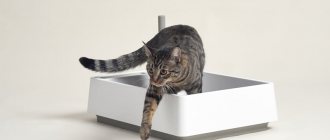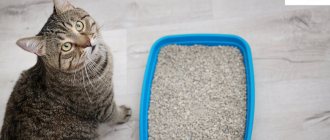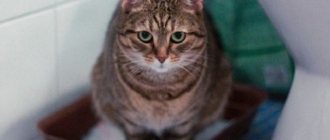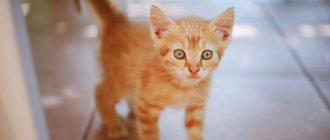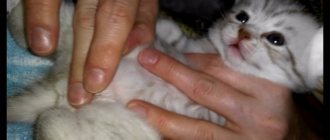Caring owners should know how often the cat goes to the toilet.
These indicators will help identify the disease at an early stage. Disturbances in defecation and urination may indicate the development of the disease. Therefore, any significant deviations from the norm are a reason to show your pet to a veterinarian.
The primary cause may be improper feeding and, as a result, disruption of the digestive system. In this case, it is enough to adjust the animal’s diet and establish the correct food intake.
Frequency of urination in cats
The daily urine volume can range from 50 to 200 ml. The frequency of urination and the amount of fluid released depends on the age, gender, and size of the animal. And also on feeding and the volume of fluid consumed.
For example, kittens can visit the litter box up to 10 times a day. This is due to the small volume of the bladder and is the norm for babies. With age, the number of visits decreases to five times a day.
Due to the physiological characteristics of the body, cats visit the litter box more often than cats. The norm for urination for an adult cat is 5–6 times. The frequency of trips to the toilet does not depend on whether the cat is neutered or not.
Adult cats go to the litter box about 3 times a day. The number of visits to the tray may increase during pregnancy and nursing. Also, the number of trips may increase when drinking large amounts of liquid, for example, in the heat or after eating dry food. If there are no natural reasons for frequent urination, then you should consult a veterinarian.
If your cat visits the litter box less than twice a day, you should immediately contact a veterinary clinic. Retention and decrease in urine volume can be symptoms of the development of pathologies in the animal’s body.
Associated symptoms
Depending on the cause of frequent urination, it may have various accompanying symptoms:
Against a background of stress
, in addition to the fact that the cat often pees, it can hide in closets, under the bed, and refuse food and water.
For bacterial cystitis
The cat usually doesn't feel well. She is lethargic, eats little, and may even vomit.
For urolithiasis
, especially when it is completely difficult to empty the bladder, cats stop eating and drinking. They constantly run into the tray, sometimes even sleep there, regularly strain on the tray and meow pitifully. As a rule, cats also have severe stomach pain, and they do not allow it to be touched.
With mechanical damage to the bladder
After catheterization, a sharp deterioration in the cat’s condition may be observed. There is urination with blood, cystitis, or, conversely, its complete absence. Also, due to the pain factor, the cat may refuse to eat and generally be sad.
Presence of a tumor in the bladder
, as a rule, has no other symptoms other than frequent urination. The condition is characterized by a gradual deterioration.
For kidney diseases
cats begin to lose weight, their coat becomes dull and dirty. Cats often refuse to eat and vomit occasionally. It is also common for cats with kidney disease to have bad breath. Cats become sad, don’t play, and sleep all day.
For diabetes
, in addition to profuse thirst and constant urination, the pet is characterized by significant obesity and the so-called perverted appetite - cats may begin to eat foods that they have never eaten before. But at the same time, with an excessive increase in blood sugar levels, on the contrary, cats may become lethargic and refuse to eat.
In the presence of hormonal diseases
cats can have a variety of symptoms. Often this is a sharp decrease in weight, poor coat quality, and the belly may be enlarged. At the same time, appetite, as a rule, does not disappear, and may even increase.
How often should kittens go to the litter box?
The frequency of bowel movements depends on the feeding regimen and the age of the pet. For example, kittens from 20 days old, with a partial transition to solid food, go to the toilet approximately five times a day. As kittens grow older, they are switched to adult food and by the age of three months, kittens generally walk no more than 4 times a day. From about 6 months, the norm is to visit the litter box once or twice a day.
When introducing new food products into a kitten's diet, short-term disturbances in intestinal function are almost inevitable. Diarrhea or constipation during the day is not a cause for concern. If the kitten’s general condition is stable, then a visit to the veterinary clinic is not required.
Main
- There are many reasons for frequent urination, from cystitis to serious systemic diseases.
- Regardless of age, if a cat pees often and little, this is always a pathology that needs to be understood and treatment selected.
- To make a diagnosis, a comprehensive diagnosis is required. In most cases, this is a urine test, blood tests, and ultrasound of the genitourinary system.
- There is no symptomatic treatment in this situation, since in each specific case it is necessary to look for the cause of the disease and treat it.
How often do adult cats go to the litter box?
Adult cats visit the litter box much less often than young animals. Some pets are limited to 1 bowel movement per day.
There are cats that go to the litter box once every two days. This is not associated with pathological changes, but is an individual feature of the animal. A health hazard may arise if a cat does not go to the toilet for more than 4 days.
The frequency of bowel movements depends not only on the age, but also on the character of the pet. Some cats may intentionally leave small odorous piles in unexpected places throughout the day. The reasons may be a change in diet, stress, rough treatment of the pet, a new pet and other factors.
In this case, the cat's health is not in danger. This behavior can be corrected by identifying and eliminating the causes of anxiety and irritation. And also achieve mutual understanding with your pet.
Another reason for improper functioning of the gastrointestinal tract may be an unbalanced diet. If there is a high content of protein or fiber in the animal’s body, a malfunction occurs. Indigestion can be eliminated by adjusting your diet.
Elderly cats
As pets age, changes occur in their bodies that affect the frequency of trips to the toilet. In older animals, defecation may occur once every two days. The color and consistency of stool also changes. Unformed or too hard stool is normal.
It is important to monitor your pet's overall health. If the animal feels well and exhibits normal activity, then you should not consult a doctor. But if the cat moans during bowel movements or sits on the tray for a long time, then it is better to seek advice from a specialist.
Treatment
For cystitis due to stress
sedatives are prescribed, such as “express calm” for cats or special diets (royal canin calm). But it is important to understand that treatment will be ineffective if the cause of stress is not eliminated.
Bacterial cystitis
treated with antibiotic therapy. But it should be noted that to make a diagnosis and select a drug, it is necessary to conduct a special study. This is taking a sterile urine sample through a puncture of the abdominal wall and submitting it for bacteriological culture with antibiotic titration (that is, selecting a drug that best copes with the found bacterium). Only in this case is it possible to defeat the infection, prevent its reoccurrence and the development of antibiotic-resistant strains of microorganisms.
Treatment of urolithiasis
completely depends on the nature of the stones that are found in the cat, so analysis is indispensable. For example, if struvite salts (synonym - tripel phosphates) are detected in a urine test, it is sufficient to prescribe a special diet (for example, royal canin urinary) and improve the cat's drinking regime (switching to wet food, purchasing special fountains for cats, from which they drink water more readily, than from a bowl). Other types of salts (for example, oxalates) require an individual approach and a treatment regimen depending on the concomitant diagnoses in the cat (for example, these salts are often found in cats with kidney disease).
Mechanical damage to the bladder
after catheterization requires the development of treatment tactics in each specific case. Pain medication, antibiotics, and even possible surgery may be needed.
If you suspect a tumor in the bladder
First, a histological analysis is taken to determine the type of tumor. Depending on the results, treatment is prescribed - chemotherapy, removal of the tumor or the entire bladder.
In most cases of kidney disease
, unfortunately, are incurable and require only supportive treatment. But, in modern conditions, with timely treatment, it is possible to extend the life of a cat with kidney disease by several years!
Diabetes
in cats, as in people, it requires insulin injections, and necessarily a special diet and weight loss. With timely treatment, constant monitoring of blood sugar levels and individual selection of insulin dosage, in about half of cases, diabetes in cats can be completely cured!
Various hormonal diseases
require constant monitoring of blood tests and selection of the dose of hormonal drugs. In some cases, if the disease is caused by a tumor, surgery to remove it is recommended. Only an endocrinologist can deal with such patients.
Impaired formation of feces
Short-term diarrhea may be caused by changes in feeding composition, stress or overeating. If you have one-time loose stools, you do not need to go to the clinic. But if diarrhea continues for several days, then you should contact a specialist.
Main causes of diarrhea:
A sudden change in diet. New feeds and individual components should be introduced gradually.- Inappropriate feed composition. Sometimes pets, due to the characteristics of their bodies, do not digest certain foods well. The problem can be solved by reviewing and adjusting the diet.
- Poor quality feed.
- Metabolic disease.
- Worm infestation. Toxins and waste products of worms lead to poisoning of the animal’s body.
Diarrhea can also be caused by neoplasms, infections, bacteria, peptic ulcers and other pathologies. To make an accurate diagnosis, you should contact a veterinary clinic. The doctor will conduct an examination and prescribe appropriate tests.
Causes of constipation:
- Excess protein in the diet.
- Dehydration of the body. Usually develops when feeding dry food without free access to water.
- Obstruction or blockage of the intestine. For example, bloat, tumor, hairballs or worms.
- Decreased activity.
- Constant or severe stress.
Before diagnosis, the animal should not be given laxatives. Increased intestinal motility due to blockage can lead to the death of the pet. If constipation persists for 2–3 days, you should consult a veterinarian.
What should be done in case of deviations from the norm?
Prolonged violation of the litter tray requires urgent contact with a veterinarian. First of all, it is necessary to establish the cause, and then carry out treatment.
Most deviations from the norm can be treated by adjusting the diet. But some diseases require urgent intervention and long-term therapy.
Diagnostics
As noted above, if a cat pees often, there can be many reasons for this. Therefore, in order not to miss a serious deterioration in the pet’s health and to begin treatment on time, it is necessary to conduct a full diagnosis.
Diagnostics must include:
- Detailed urine analysis.
It looks at the density of urine (kidney function), the amount of protein (inflammation, kidney function), the presence of sugar (diabetes), acidity, sediment, and so on. Each of these indicators can be decisive in making a diagnosis.
- General blood analysis.
It may show the presence of bleeding due to bladder injury, an increase in the number of white blood cells due to infection, etc.
- Blood biochemistry.
It shows blood sugar levels and allows you to evaluate kidney function (creatinine, urea, phosphorus). Elevated liver enzymes may indicate the presence of endocrine diseases.
- Ultrasound of the genitourinary system
. This is the most important diagnostic method that allows you to assess the condition of the bladder, in particular its walls, the presence of stones, salts, and neoplasms. The condition of the kidneys, ureters, and the visible part of the urethra is also necessarily assessed.
But, of course, there are exceptions when drawing up an examination plan. For example, if the pet is young, he has not had any health complaints and there is a suspicion of stress
, in most cases, you can limit yourself to performing an ultrasound of the abdominal cavity.
If bacterial cystitis
, urine must be collected in a sterile manner using cystocentesis (puncture of the abdominal wall) and sent for analysis: bacteriological culture with selection of an antibiotic.
Make an accurate diagnosis of urolithiasis
is possible only by submitting the removed stone for a special analysis to determine its structure.
If you suspect mechanical damage to the bladder
After catheterization, ultrasound may be sufficient. But, to assess the dynamics of recovery, it is necessary to conduct several examinations.
When visualizing a tumor in the bladder
, in addition to a complete examination of the cat to exclude the presence of other neoplasms (in this case, it is best to perform a computed tomography), to take a piece of the tumor for histology analysis, a puncture (biopsy) is required. Only in this case can the nature of the tumor be determined and special treatment prescribed.
If you suspect kidney disease, diabetes mellitus and other hormonal
The disease requires a thorough and comprehensive diagnosis of the pet. Also, in each specific case, the doctor may prescribe additional tests to clarify the diagnosis (for example, blood tests for indicators such as SDMA, cortisol, etc.)
Hurry up, choose a box and find out what gift awaits you
Discount on pet insurance
Promo code copied to clipboard
What are the reasons for deviations from the norm?
A distinction is made between pollakiuria—frequent urination and oliguria—decreased urine volume with infrequent visits to the litter box.
Pollakiuria develops for the following reasons:
- Aging : The sphincter of the bladder relaxes and urine flows to the outlet valve of the urethra. The pet squats all the time, trying to defecate,
- Cystitis : inflammation of the bladder accompanied by frequent and painful urination.
- Inflammation of the prostate: mainly affects older pets.
- Stress : fright, the appearance of a new pet in the apartment, the appearance of the owner after a long absence.
- Pathological conditions that cause thirst - poisoning, infectious or non-communicable diseases are accompanied by an increase in trips to the litter box.
Oliguria is associated with dehydration, which occurs with prolonged vomiting and diarrhea, or urolithiasis, when a complete cessation of urination is possible. This condition is called anuria, it threatens the life of the animal and requires emergency veterinary care.
Prevention
The incidence of urolithiasis in cats is five times higher than in cats. This disease is one of the most frequently diagnosed after helminthic infestations.
Proper metabolism prevents the formation of stones, so a balanced diet is the key to health, especially when it comes to castrated and sterilized cats. These are truisms, but owners, even when buying premium food, do not comply with the feeding standards indicated on each package, so they mix the finished product with natural food.
Lack of water is one of the reasons for the formation of urate stones, and since cats have a poorly developed sense of thirst, there is a good way to teach your pet to drink more. Place several different vessels with water in different places in the house, this invariably arouses interest in the animals and a desire to try.
Protect your cat from hypothermia. Don't let him sit on a freshly washed floor until it's dry, and don't let him sleep on the floor under an open window. And, of course, watch how often the cat pees. This is the most important marker in home diagnostics of a pet’s health condition.
When should you contact a veterinarian?
Having noticed that the cat has begun to rarely visit the litter box, it is necessary to observe whether other symptoms have appeared. If they are there, you can’t hesitate. Atypical behavior when urinating - a strange posture, meowing - should alert you.
Pathology is indicated by weakness, lethargy and apathy, excessive appetite or refusal to eat, and weight loss. Other reasons to contact a veterinarian:
- indigestion (vomiting, diarrhea or constipation);
- increased or decreased body temperature;
- pallor of the mucous membranes;
- uncharacteristic impurities in the urine (pus, blood);
- strong unpleasant odor of urine.
Some diseases have subtle symptoms, so if the deviation in the number of urination acts persists for more than 3 days, you should show your pet to a doctor. Under no circumstances should you self-medicate; this can aggravate the situation and lead to dangerous complications.
How much urine should be produced during pregnancy?
Consultation with a hepatologist and gastroenterologist
Go to online consultation:
1).
consultation with a hepatologist-gastroenterologist
;
2). consultation with a gynecologist
;
3). consultation with a urologist
;
4). pediatrician
consultation ;
5). consultation with a dermatologist
;
6). consultation with a narcologist
;
7). consultation with an otolaryngologist
;
8). surgeon
consultation ;
9). consultation with a proctologist
Good afternoon, what color should pregnant women’s urine be? If it is yellow and cloudy, is this normal? I take vitamins Prental Vitrum.
Hello. Yellow urine is normal, but cloudy urine is not so much. When was the last time you had a urine test? What is the gestational age?
Inflammation of the genitourinary system - cystitis, pyelonephritis, urinary diathesis. Pregnant women have a lot of stress on their kidneys, there is no need to take risks, it is better to be safe. And it’s time to register, when do you plan?
My kidneys don’t really hurt, but sometimes my lower back hurts. I go a little often. When I go. does not hurt. But before pregnancy I was diagnosed with chronic cystitis. Which I treated (like orgil) and planned a pregnancy after I drank it. (The doctor said so) I plan to register in 3-4 weeks.
Hello. I’m worried. A month ago, things went well for me twice, the second time it somehow hurt and I was craving something salty or sour, now only the smells irritate me and I felt sick three weeks ago, now the delay is a week, even more. and the urine was cloudy, I wanted to do a test, I bought it, but it wasn’t there, but that’s not the main thing..what can you say?
delay 3rd day, positive test. Urine was cloudy for 2 days, passed a general urine test - reaction ph8, specific weight 1.015. a week ago I took 4 tablets. furadonina-kidney was sick (I didn’t suspect pregnancy yet). Are these bad indicators? Do they indicate poor kidney function?
Source
